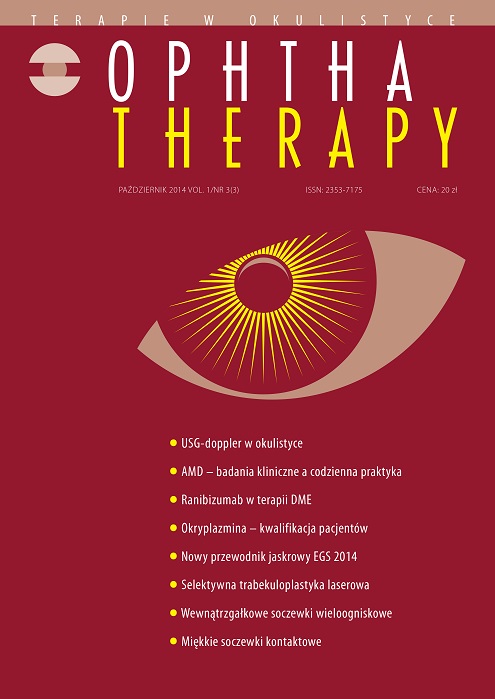Qualification of patients for multifocal intraocular lens implantation – own experience
Main Article Content
Abstract
Surgical treatment consisting in own lens removal and replacing it with artificial one is the most frequently performed procedure in ophthalmic surgery worldwide. Except cataract extraction more often cristal lens removal is being performed with artificial lens implantation as a method for presbyopia correction (PLE) or refractive surgery (CLE). Currently patients require not only excellent distance vision but also intermediate and near vision, perfectly without need for additional spectacles correction. In such cases the perfect solution is multifocal intraocular lenses use. Due to its’ optical properties AcrySof ReSTOR let patients achieve comfort vision for all distances. Proper patients qualification in association with meeting their visual needs, detailed ophthalmological examination and perfectly performed surgical procedure allows achieving long-term very good distance, intermediate and near vision without any spectacles dependence.
Downloads
Article Details

This work is licensed under a Creative Commons Attribution-NonCommercial-NoDerivatives 4.0 International License.
Copyright: © Medical Education sp. z o.o. License allowing third parties to copy and redistribute the material in any medium or format and to remix, transform, and build upon the material, provided the original work is properly cited and states its license.
Address reprint requests to: Medical Education, Marcin Kuźma (marcin.kuzma@mededu.pl)
References
2. Gundersen KG, Potvin R. Comparative visual performance with monofocal and multifocal intraocular lenses. Clin Ophthalmol. 2013; 7: 1979-85.
3. Montés-Micó R, España E, Bueno I et al. Visual performance with multifocal intraocular lenses; mesopic contrast sensitivity under distance and near conditions. Ophthalmology. 2004; 111(1): 85-96.
4. Alfonso JF, Fernández-Vega L, Baamonde MB et al. Prospective visual evaluation of apodized diffractive intraocular lenses. J Cataract Refract Surg. 2007; 33(7): 1235-43.
5. Davison JA, Simpson MJ. History and development of the apodized diffractive intraocular lens. J Cataract Refract Surg. 2006; 32(5): 849-58.
6. Kohnen T, Allen D, Boureau C et al. European multicenter study of the AcrySof ReSTOR apodized diffractive intraocular lens. Ophthalmology. 2006; 113(4): 578-84.
7. Chiam PJT, Chan JH, Aggarwal RK et al. ReSTOR intraocular lens implantation in cataract surgery: quality of vision. J Cataract Refract Surg. 2006; 32(9): 1459-63.
8. Morgan-Warren PJ, Smith JA. Intraocular lens-edge design and material factors contributing to posterior capsulotomy rates: comparing Hoya FY60aD, PY60aD, and AcrySof SN60WF. Clin Ophthalmol. 2013; 7: 1661-7.
9. Leydolt C, Schriefl S, Stifter E et al. Posterior capsule opacification with the iMics1 NY-60 and AcrySof SN60WF 1-piece hydrophobic acrylic intraocular lenses: 3-year results of a randomized trial. Am J Ophthalmol. 2013; 156(2): 375-81.
10. Li Y, Wang J, Chen Z et al. Effect of hydrophobic acrylic versus hydrophilic acrylic intraocular lens on posterior capsule opacification: meta-analysis. PLoS One. 2013; 8(11): e77864.
11. Ferrer-Blasco T, Montes-Mico R, Peixoto-de-Matos SC et al. Prevalence of corneal astigmatism before cataract surgery. J Cataract Refract Surg. 2009; 35(1): 70-5.
12. Chen W, Zuo C, Chen C et al. Prevalence of corneal astigmatism before cataract surgery in Chinese patients. J Cataract Refract Surg. 2013; 39(2): 188-92.
13. Bauer NJ, de Vries NE, Webers CA et al. Astigmatism management in cataract surgery with the AcrySof toric intraocular lens. J Cataract Refract Surg. 2008; 34(9): 1483-8.
14. Pepin SM. Neuroadaptation of presbyopia-correcting intraocular lenses. Curr Opin Ophthalmol. 2008; 19(1): 10-2.

